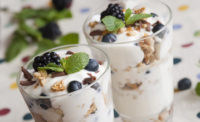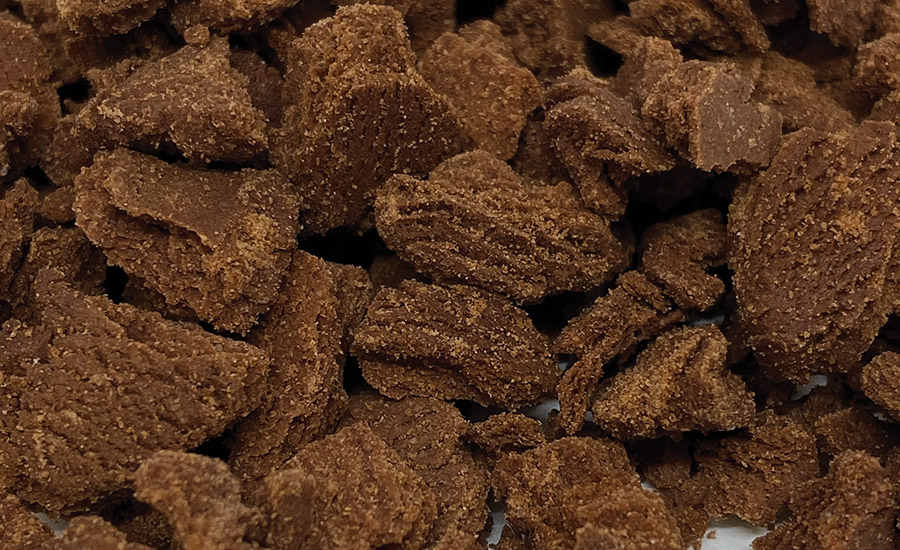Inclusions with a health halo
Inclusions have long been associated with indulgence. Now they’re getting a healthy makeover








Surprise bites of chocolate chips, cookie dough, pie pieces and other miniature treats have long delighted ice cream and frozen dessert consumers. But today’s health-conscious eaters are asking for more from their desserts, including the inclusions within them, than an indulgent, satisfying mouthful.
“In order to stay in sync with evolving consumer preferences, food manufacturers must deliver products that appeal to wide range of dietary needs, including gluten-free, soy-free, dairy-free and vegan diets — to name a few,” says Jeff Smith, director of innovation, global ingredients division, Blue Diamond Almonds, Sacramento, Calif.
How do you be everything to everyone? Many ingredient suppliers have realized that there’s not a one-inclusion-fits all approach, so they’re offering lines that run the gamut of dietary, flavor and nutrition preferences.
Take Star Kay White, a Congers, N.Y.-based supplier that has been around for 129 years. According to Caroline Vogel, director of new business development, the company’s current inclusion offerings address consumer desires for no sugar, lower sugar, nondairy, Non GMO Project Verified and fair trade products.
“Our unique ingredients can include nuts, seeds and a range of fruits to meet multigenerational interests,” she continues. “These applications are for both the dairy and nondairy frozen and refrigerated desserts.”
Other suppliers are following suit, including Portland, Ore.-based Icon Foods.
“Icon Foods has a priority initiative to launch at least 10 new variegates and inclusions targeting keto [ketogenic diet], low-carb and clean-label,” says Thom King, president and CEO.
Keep it whole
While new diets pop up all the time, clean-label eating has proven not to be a passing trend. And many dairy processors are looking for inclusions that fit this transparency bill, says Smith.
“Product developers are innovating with a focus on natural, familiar inclusions that also offer nutritional benefits,” he says.
Jennifer Williams, marketing director for the Folsom, Calif.-based California Walnut Board and Commission, agrees that familiarity is key for consumers who want to understand what is going into their foods.
“Consumers are starting to pay close attention to what’s really in some of these products, and they often find lengthy ingredient lists with unfamiliar names,” she explains. “When using a whole food inclusion or ingredient such as walnuts, food and beverage manufacturers can attain flavor, texture and functionality all while maintaining a simple ingredient listing.”
Inclusions made from whole foods such as nuts are gaining in popularity, notes Smith. He points to data from Innova Market Insights, which show that almond introductions in the frozen dessert/ice cream category had a 10% year-over-year increase in 2018. Almond introductions in the overall dairy category grew 10%.
“As manufacturers strive for a simpler label, almonds stand out as one of the most sought-after clean inclusions due to their long history of providing taste, texture and nutrition to a variety of food and beverage products,” says Smith.
Real fruit inclusions are another way for food processors to meet consumer demand for recognizable ingredients.
“Fruit is a natural as an inclusion in dairy, because both fruit and dairy products have a healthy halo,” says Jeannie Swedberg, director of business development for Tree Top Inc., Selah, Wash. “And they can complement each other. Fruit makes an ideal inclusion in yogurts or dairy-based desserts. It can be used alone or in combination with a crunchy inclusion such as nuts or granola.”
Tom Payne, industry specialist for the Folsom, Calif.-based U.S. Highbush Blueberry Council, says that formulators sometimes are worried about using real fruits due to a potential lack of year-round availability, but that blueberries are available in formats that help close this gap.
“Blueberries offer important advantages in year-round formats which provide the freshness of blueberries with the convenience of year-round availability,” he says. “Formats such as IQF (individually quick frozen) and case-frozen provide formulators with a range of possibilities.”
Blueberries also are available in dehydrated formats, where they are typically used if “individual piece identity is needed,” explains Payne. They also come in infused, freeze-dried and micro-dried formats.
“Infused blueberries provide chewiness and mouthfeel,” Payne notes. “Freeze-dried and micro-dried blueberries have crisp flavor notes.”
Food processors that want to clean up their labels should be aware that it could come at a higher cost for raw materials, said Paula Simons, product developer for Dallas-based Pecan Deluxe Candy Co.
“For example, spirulina is significantly more expensive than Blue #1, so there might be some cost implications from using natural color instead of artificial,” she adds.
Another challenge in using natural materials, Simons says, is that customers still expect the same amount of color and flavor intensity, which can be difficult to achieve using only natural ingredients.
Mark Hetzel, sales account manager for Star Kay White, agrees.
“The greatest formulation challenges are matching the vibrancy of artificial colors when utilizing natural colors and reducing or eliminating sugar for substitutions or new product development,” he says. “We partner with ingredient companies to help us meet the needs of our customers through new technologies, development and training.”
Payne said that blueberries are a good solution for processors looking for natural sources of vibrant color.
“The interest in ‘natural’ over ‘artificial’ ingredients has food manufacturers looking for real sources of color and flavor,” he notes. “Blueberry juice concentrate and purée may be used as coloring and flavoring agents.”
Functional benefits
It’s not just about cleaning up labels: Consumers also are looking for foods that offer specific health claims. Williams says walnuts fit this bill as they “are the only tree nut with a significant source of plant-based omega-3 ALA at 2.5 grams per ounce.”
While healthful, walnuts also can be indulgent. For example, they can be made into a walnut compound butter that can be used as an inclusion.
“Categories such as ice cream and bakery have always been viewed as indulgent offerings, and still are for the most part,” Williams explains. “However, by using whole food inclusions such as walnuts, manufacturers are adding nutritious properties to products without sacrificing taste.”
Almonds are another whole food inclusion that have a health halo.
“Compared to other tree nuts, almonds contain the most protein (6 grams) and fiber (4 grams) per ounce,” he says. “They are an excellent source of vitamin E and magnesium and a good source of calcium, riboflavin, potassium and phosphorous.”
Almonds are a versatile inclusion, too: Blue Diamond offers them “sliced, diced, slivered or split, as well in flour, butter and protein powder,” says Smith. They can be used in products throughout the dairy category.
“For example, diced, sliced and slivered almonds can serve as an elegant topping on cheesecakes, sundaes and ice cream bars. Consumers also love almonds as a crunchy yogurt mix-in, and gourmet yogurt flavors often leverage almond and fruit inclusions to achieve a more premium product positioning,” adds Smith. “Additionally, almond butter can be used as an indulgent inclusion in ice cream, adding a rich, creamy texture.”
Smoky Waters, a chef and director of culinary innovation for Pecan Deluxe, notes that customers aren’t necessarily looking for foods with fewer calories; they are looking for products that are “perceived to be good for you.”
This has led to a rise in consumer interest in seeing certifications on food labels, he notes, including organic and Non GMO Project Verified. However, processors should be aware that these label claims often come with higher costs in terms of raw materials.
For its part, the U.S. Highbush Blueberry Council created a “Real Blueberries” seal for labels, notes Payne.
“It helps buyers — from the ordinary consumer to food professionals — identify real blueberry products,” he says. “Products must contain real highbush blueberries in any form and use an adequate amount of blueberries as standard in a certain product category.”
Food safety concerns
Customers looking for clean-label products also are paying attention to food-safety issues, says Heidi Farkas, national sales and marketing manager, Milne MicroDried, Nampa, Idaho. They want to ensure what they are eating is chemical- and additive-free.
“Growing public awareness and concern for food safety [are] also bringing microbe levels, shelf life and purity … to the forefront,” she notes.
To assuage this concern, Milne MicroDried’s dried fruit inclusions are produced with a “kill step” that reduces microbe levels. They also are certified as “ready-to-eat” by Eurofins Scientific, which means they can be eaten from the package and require no further processing.
Mine MicroDried’s products also match consumers’ other clean-label requirements.
“MicroDried fruits and vegetables are 100% pure plant-based ingredients that naturally address many of today’s consumer issues — there are no added sugars, colors or preservatives of any kind in our ingredient products,” notes Farkas. “All of our varieties are clean label with a single ingredient statement — i.e., ‘Blueberries.’”
No sugar on top
Consumers a decade ago may have looked for low-fat and nonfat products if they wanted to slim down their waistlines, but now the healthy choice du jour is less sugar. And while consumers still want their desserts to taste good, many look for label claims such as “no added sugar” to give them permission to indulge.
“Inclusions and variegates are typically made of sugar, a real diet buster,” says King. “Sucrose adds four calories per gram. It also induces a glycemic response.”
He adds that artificial sweeteners often are used to reduce sugar in inclusions, but this contrasts with consumer preference for “natural” foods. In response, Icon Foods created a line of sugar-free marbits, sprinkles and chocolate chips sweetened with erythritol, stevia extract and monk fruit.
“Erythritol is produced through natural fermentation. It has just 0.2 calories per gram. Stevia extract is a zero-calorie, high-potency plant-derived sweetener,” King notes. “Together, they allow the rich flavor to shine while providing a guilt-free, sugar-like flavor that’s subtly sweet without any aftertaste.”
Pecan Deluxe also has responded to processors’ requests for sugar reduction.
“We have created several baked items formulated with chicory root fiber and stevia instead of added sugar,” notes Claudia Granda, vice president of research and development. “Our most popular ones are our pie chips and brownie brittle.”
The company also developed a brownie brittle inclusion that is sugar-free, gluten-free and vegan, notes Simons. It was made without sugar alcohols and artificial sweeteners.
Using real fruits as inclusions is another way to reduce sugar, explains William Weiskopf, vice president of sales and new business development, FruitCrown, Beloit, Wis.
“We are able to provide excellent flavor impact by formulating with a unique blend of sweetener enhancers and natural flavorings, while using our own proprietary process that magnifies the end flavor while maintaining full fruit integrity and uncompromised fruit,” he says.
iTi Tropicals Inc., Lawrenceville, N.J., a fruit supplier, said it can assist processors that want to reduce sugar with its many fruit products.
“As far as low-sugar, we have items like acai, passion fruit, acerola and … coconut water to address the need for lower sugar fruits,” says Don Giampetro, the company’s vice president of quality and innovation. “These fruits either contribute lower sugar levels, or because they are so impactful on flavor, they are utilized at much lower usage levels but still contribute significant flavor.”
Plant-based bites
The rise of veganism continues to influence the dairy space, and many processors are looking for nondairy inclusions to add into their plant-based products.
“We are seeing more and more ‘vegan-friendly’ inclusion trends as the dairy trend continues to move towards plant-based nondairy ice creams and yogurts,” said Simons. “The nondairy items now need nondairy inclusions to complement their flavors.”
However, it’s not just vegans who are requesting nondairy options. So called “flexitarians,” who sometimes eat vegan and sometimes do not, are interested in introducing more plant-based products into their diets, says Claudia Granda, vice president of research and development for Pecan Deluxe.
“A growing global interest in plant-based diets is leading consumers to incorporate more fruits, seeds and nuts into the foods they eat,” notes Smith.
He said that this consumer demand for more plant-based products has led to an increase in almond usage by the company’s manufacturing partners. He has seen the nuts show up in a number of new application areas.
King said Icon Foods has responded to the plant-based trend by creating a line of vegan inclusions.
“Icon Foods offers plant-based, no-added-sugar marbits, sprinkles, and dark chocolate, white chocolate and toasted marshmallow chips,” he said. “A 1-ounce serving (28.35 grams) has under 99 calories with no added sugar.”
Like with clean-label formulation, processors should be aware that vegan formulation can come at a higher price point, says Granda.
“For vegan items, our standard products need to be reformulated with unique ingredients that can meet the vegan claim, which frequently translate to higher minimums and costs,” she explains.
Looking for a reprint of this article?
From high-res PDFs to custom plaques, order your copy today!












